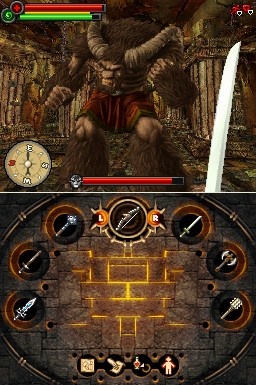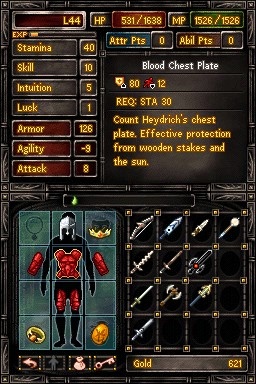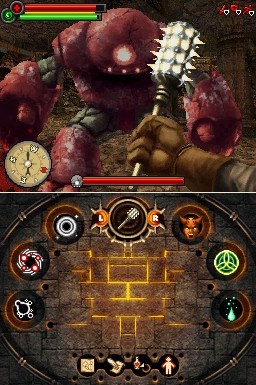Fighting Fantasy: The Warlock of Firetop Mountain is an action role-playing game modeled after the Fighting Fantasy adventure-novel franchise. Yet the game ignores the the most interesting aspect of the franchise--choosing between branching story paths. The disappointingly linear adventure unfolds in a dark 3D world full of hidden paths to explore, and the first-person perspective gives you an in-your-face view of your various monstruous enemies. Unfortunately, The Warlock of Firetop Mountain squanders what little potential it has, and the vexing control scheme, shallow combat, and tendency to freeze up randomly make this a crummy and frustrating dungeon schlep.

In Fighting Fantasy, you're cast as a wandering adventurer who arrives at a small town to pilfer its nearest dungeon. That dungeon is known as Firetop Mountain and is the home of a treasure-hoarding wizard you're there to rob. The story is predictable and unappealing, as well as disappointingly scant. One of the game's most baffling elements is that it completely overlooks the key feature of the adventure-novel series it's based upon: the ability for you to choose your destiny by making story decisions. What little story or character interaction there is can barely be called a plot. The most significant choices you get to make are during character creation. You answer a few questions to determine your class as a wizard, a warrior, or a rogue. The classes are clearly unoriginal, but you do have a decent amount of control over your character's growth. You can manipulate base stats, such as stamina, to increase your health pool while investing skill points acquired by leveling into abilities and spells, like lightning magic or axe proficiency.
You're limited to exploring a single dungeon with the aid of a predominantly useless compass that rarely displays your active objective. Many of the rooms share the same basic design and name, which makes it difficult to discern which "orc den" or "temple" you're headed to, resulting in tedious backtracking. Conveniently, you're able to mark your map, but the lack of a minimap overlay means you're constantly stopping to do so, which quickly gets annoying.
Combat is simplified to such an extent that any fun that could be had striking down mythical beasts has been wrenched painfully from this disappointing adventure.. You simply mash the attack buttons or spam spells to bring down a target that's stumbling your way. Alternatively, you can capitalize on the game's poor AI and position yourself behind a pillar, safely tossing fireballs from a distance while you watch your enemy continuously run itself into a wall. Bosses are pushover idiots that you can usually implement the same tactic for. Although taking advantage of the asinine AI is one way in which to easily dispatch bosses, a handy bug occasionally crops up that makes the combat even easier, though still painfully boring. You fall clean through the ground and can mash attack from underneath the boss, who typical stands there to take the beating.

The control scheme is terribly uncomfortable and may result in many irritating deaths. You manipulate the camera by sliding the stylus across the touch screen or pressing the face buttons, while you attack by tapping the touch screen or pressing the shoulder buttons. It's tricky to maneuver the camera with the stylus while you're also tapping spells, yet it's next to impossible to maneuver the camera with the face buttons because they force you to attack with the shoulder buttons, which prevents you from selecting spells and items on the touch screen unless your right hand grows an extra thumb. It also means that your eyes are bouncing everywhere, simultaneously focusing on your health, control style, spells, item usage, and enemies, which is a precarious and awkward feat. Targeting is a hassle because performing any movement (including attacks) slightly positions you off-center, ruining your aim because targeting is determined by the direction you're facing. This forces you to constantly correct your aim with both the D pad and stylus--a nuisance that a simple autotargeting feature could fix.
Almost all of the difficulty is artificially supplied, which makes the gameplay feel frustratingly cheap. It's quite easy for foes to block you into a corner and overwhelm you. One or two lucky strikes usually finish you off, and it's tough to outmaneuver your enemies because the controls are so poor. Furthermore, circling monsters in tight corridors is nearly impossible and becomes aggravating when you're tackling larger opponents. Expect to frequently die as you enter rooms because enemies spawn on top of you and immediately attack. Just turning around to exit an area is made difficult by the controls because you're using the D pad to maneuver and the stylus to simultaneously redirect the camera and attack.
On the rare occasions that you're not struggling with the problematic controls, you're free to experience the lackluster adventure. Quests are bland endeavors that involve you either fetching items or killing monsters, so expect to spend plenty of time retracing your steps. It doesn't help that what little direction you're given is often unclear; you have a quest journal, but the instructions are often sketchy and cause additional backtracking as you search for any clue as to what to do next. A lack of enemy variety will cause you to quickly tire of toppling the same foes cast in a different color palette, while countering the same primitive skills--such as fireballs and icicles--gets dull and repetitive. Although you have a good repertoire of abilities, they never mature into deadly, elite forms. Thus, you should look elsewhere if you enjoy mastering advanced combat techniques.

The 3D world has an interesting dark aesthetic, but its crude, blocky environments are rough, with muddled texturing and clipping surrounding a few detailed elements, such as stained-glass windows. The 2D character models appear almost 3D as your circle them, but they're essentially lifeless cardboard cutouts. The world is barren due to the infrequency of character interactions and the lack of background music, and occasional slowdown makes for sluggish exploration. The choppy frame rate is odd because attack animations are so rudimentary, but random freezing is much more aggravating. Ambient noises are decent, with plenty of creepy growls, but they don't fill the acoustic void.
You could spend 10 hours or so investigating Firetop Mountain, but you'll have seen just about all the game has to offer once you've bested the wizard for your inadequate ending. You can access a new game-plus option that carries over your equipment and abilities for another play-through, but the distinct lack of additional storyline branches, interesting quests, and new areas to unlock drastically lessens the draw factor. Fighting Fantasy: The Warlock of Firetop Mountain is an inferior and empty experience beset by severely awkward controls and shoddy gameplay.